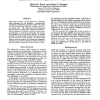Free Online Productivity Tools
i2Speak
i2Symbol
i2OCR
iTex2Img
iWeb2Print
iWeb2Shot
i2Type
iPdf2Split
iPdf2Merge
i2Bopomofo
i2Arabic
i2Style
i2Image
i2PDF
iLatex2Rtf
Sci2ools
AAAI
1994
1994
Experience-Aided Diagnosis for Complex Devices
This paper presents a novel approach to diagnosis which addresses the two problems - computational complexity of abduction and device models - that have prevented model-based diagnostic techniques from being widely used. The Experience-Aided Diagnosis (EAD) model is defined that combines deduction to rule out hypotheses, abduction to generate hypotheses and induction to recall past experiences and account for potential errors in the device models. A detailed analysis of the relationship between case-based reasoning and induction is also provided. The EAD model yields a practical method for solving hard diagnostic problems and provides a theoretical basis for overcoming the problem of partially incorrect device models.
AAAI 1994 | Device Models | Incorrect Device Models | Intelligent Agents | Model-based Diagnostic Techniques |
| Added | 02 Nov 2010 |
| Updated | 02 Nov 2010 |
| Type | Conference |
| Year | 1994 |
| Where | AAAI |
| Authors | Michel P. Féret, Janice I. Glasgow |
Comments (0)

